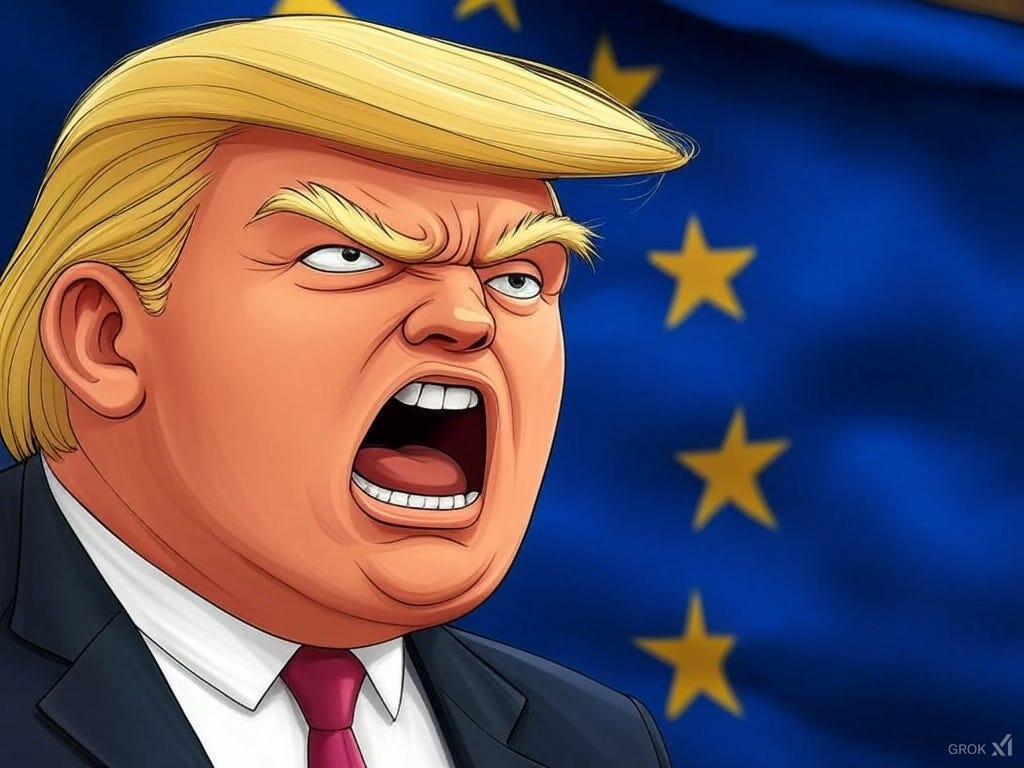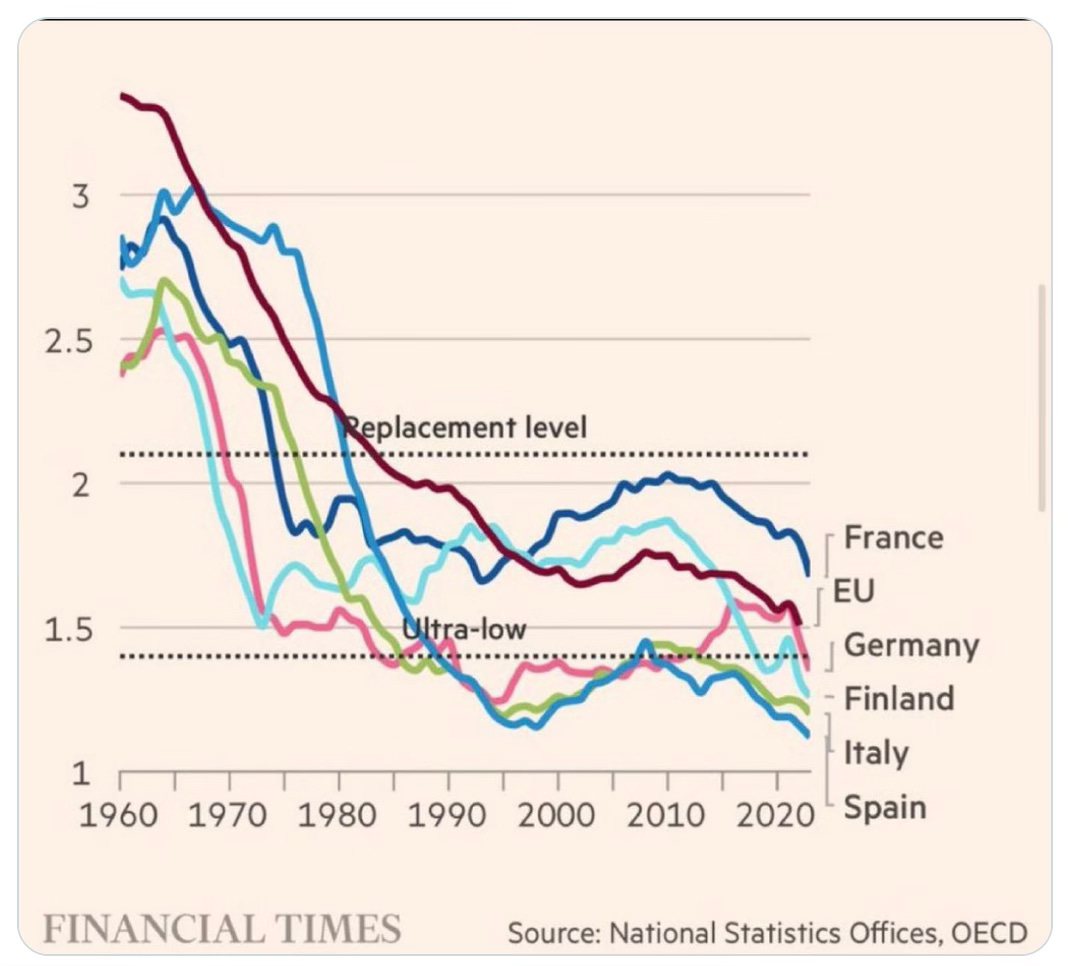David Vance SubstackRead More
The timing is perfect, as it so often is with President Trump. Yesterday he declared war on the European Union, commercial war! From here on in, 25% tariffs will be applied to certain EU exports to the USA. Here is Trump explaining his logic;
This comes the day AFTER French leader Macron had an audience with Trump and the day BEFORE he has an audience with the feverishly pro EU Sir Keir Starmer, British Prime Minister.
How will these tariffs work? Well, it’s not fully clear yet as Trump talks “in general” terms BUT certain sectors of EU trade face the hammer
First, the automotive sector stands out as a prime target. Trump has repeatedly criticised the EU for exporting millions of cars to the U.S. while allegedly restricting American car imports. Germany, the EU’s automotive powerhouse, exported around $47 billion worth of vehicles and parts to the U.S. in 2023, making it highly exposed. Companies like Volkswagen, BMW, and Mercedes-Benz could face significant cost increases, especially since the U.S. market is a key destination for their luxury and mid-range models.
Next, steel and aluminum industries are almost certainly in the crosshairs. Trump’s recent actions—raising tariffs on these metals to 25% across all countries, effective March 4—signal a continuation of his first-term focus on protecting U.S. producers. The EU exported roughly $6.4 billion in steel and aluminum to the U.S. before the 2018 tariffs triggered a truce, and any new broad 25% tariff would hit this sector hard again, affecting countries like Germany, Italy, and Spain.
Pharmaceuticals are another likely target, with Trump explicitly mentioning this sector in recent comments at Mar-a-Lago. The EU, particularly nations like Denmark (home to Novo Nordisk) and Ireland, supplies a hefty chunk of U.S. drug imports—$127 billion in 2024 alone. A 25% tariff could spike prices for medications like weight-loss drugs, impacting both consumers and manufacturers.
Semiconductors and related technology products could also feel the sting. Trump has signaled tariffs on chips starting at “25% or higher,” aiming to boost domestic production. The EU’s exports in this area, while smaller than Asia’s, include critical components from firms in the Netherlands (e.g., ASML) and Germany, potentially disrupting supply chains for U.S. tech firms.
Agriculture and food products might not escape either, though Trump’s focus has been more on EU imports than exports here. Still, iconic EU exports like French wine, Italian cheese, and Scotch whisky—hit with 25% tariffs in 2019 over the Airbus dispute—could face renewed pressure if the tariffs are truly “general.” The EU’s $576 billion in total goods exports to the U.S. in 2023 included substantial food and beverage shipments.
Finally, machinery and chemicals, which together made up 68% of EU exports to the U.S. last year, are vulnerable due to their sheer volume. Germany’s machinery exports and France’s chemical products could see costs rise, squeezing industries reliant on transatlantic trade.
Trump’s stated goal is to address a perceived $300 billion trade deficit with the EU, and his “25% generally” comment from today’s cabinet meeting suggests a blanket approach rather than a selective one.
Trump has been consistent in his view that VAT, a consumption tax applied at each stage of production in the EU, creates an uneven playing field. He argues that when U.S. goods—like cars, machinery, or agricultural products—are exported to the EU, they get slapped with VAT on top of any existing tariffs. For example, a German buyer purchasing an American car might pay a 19% VAT (Germany’s rate), making the U.S. product pricier compared to a domestically produced EU alternative. Meanwhile, EU goods exported to the U.S. don’t face a comparable federal sales tax, since the U.S. relies on state-level sales taxes (typically 0-10%) applied only at the point of sale, not on imports specifically. Trump has called this a “massive advantage” for the EU, claiming it screws American companies out of fair competition.
He’s right and now the EU has to deal with it.
If they try to tariff US exports, there is a reality check for them to ponder.
As of February 26, 2025, the U.S.-EU trade balance reflects a significant deficit for the United States in goods trade. In 2024, U.S. goods exports to the European Union totaled $370.2 billion, while imports from the EU reached $605.8 billion, resulting in a U.S. goods trade deficit of $235.6 billion. This marks a 12.9% increase—or $26.9 billion—over 2023, driven by a 5.1% rise in imports ($29.4 billion) outpacing a modest 0.7% increase in exports ($2.6 billion). Trump seeks to flatten this imbalance.
President Trump holds all the cards and the EU’s sclerotic economy faces another trad crisis.
There is one OTHER angle. The UK also charges VAT and a part of the UK – Northern Ireland – remains IN the EU so does that mean we will also face this trading challenge. Do remember Sir Keir Starmer has stated he WANTS to be closer to the Brussels tyranny. Is he about to find out?





































